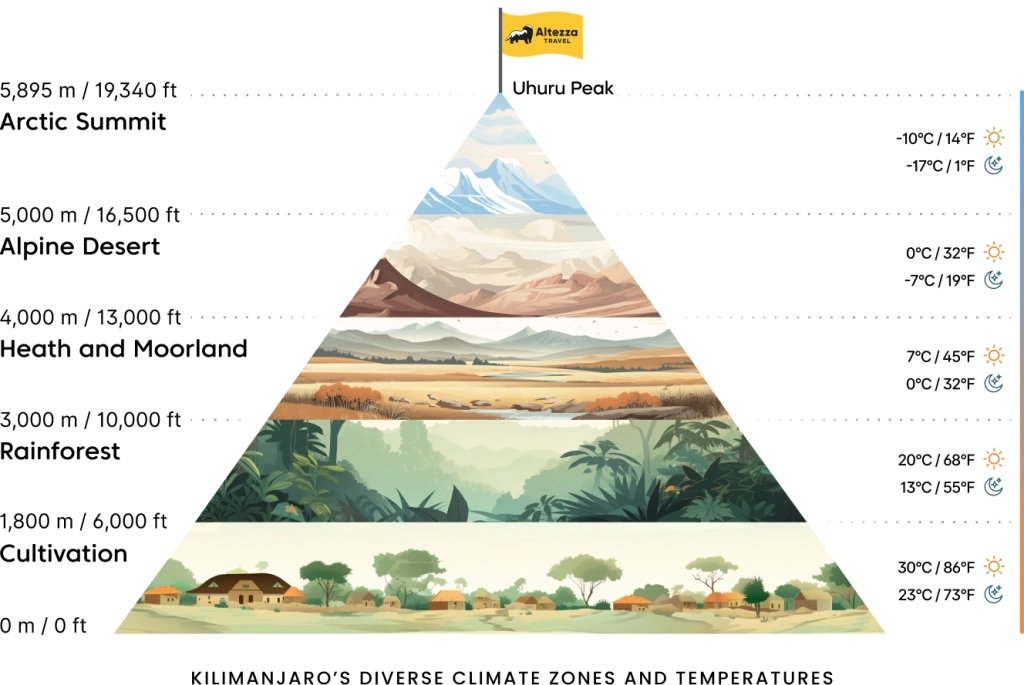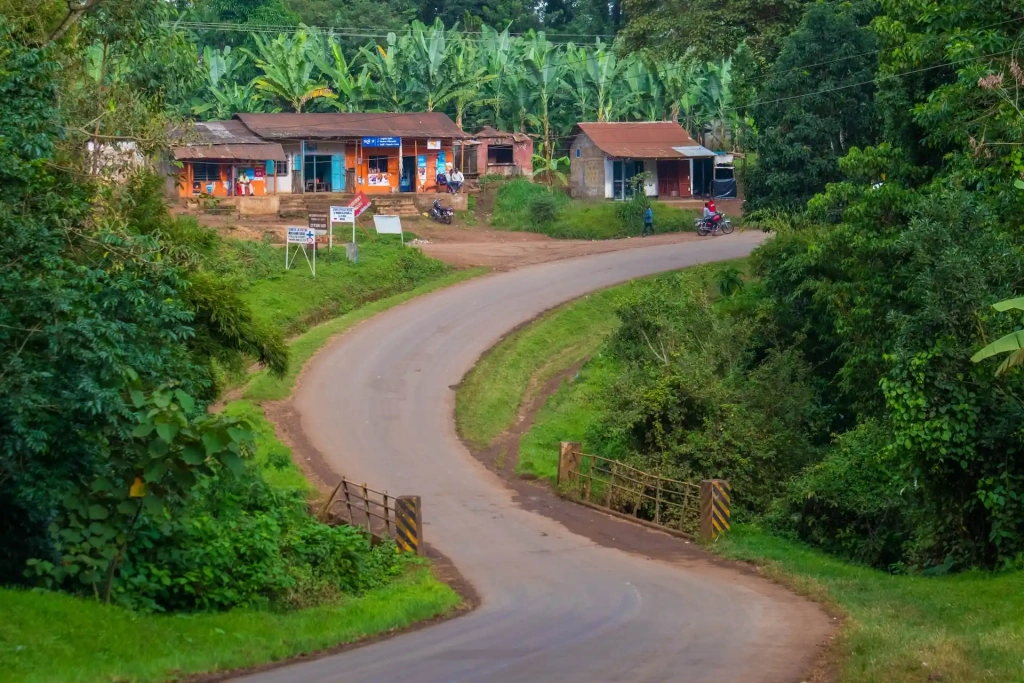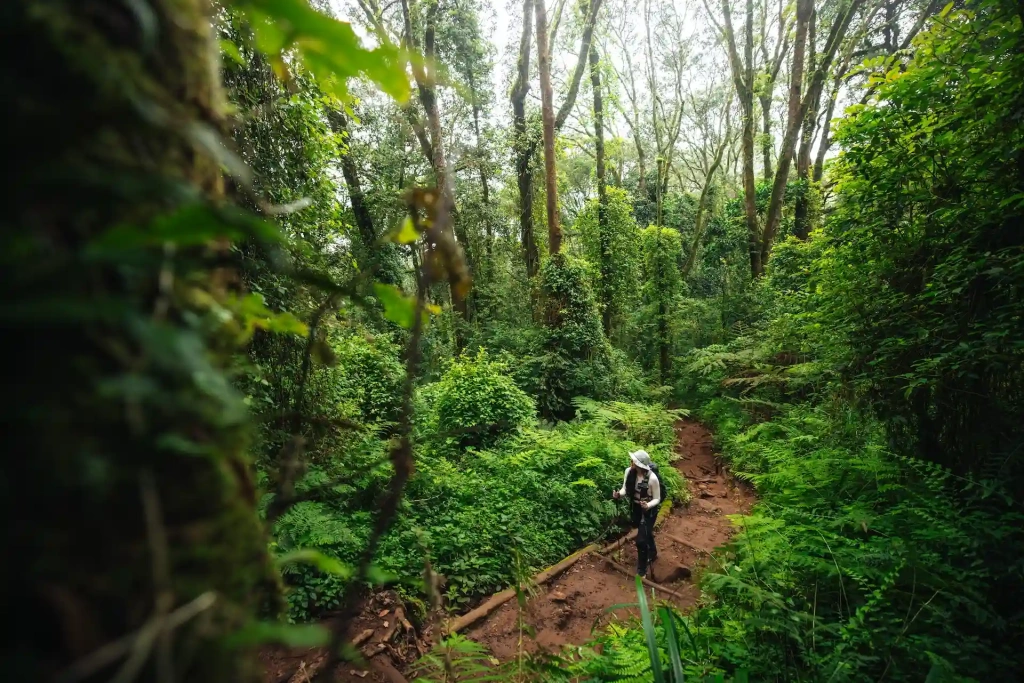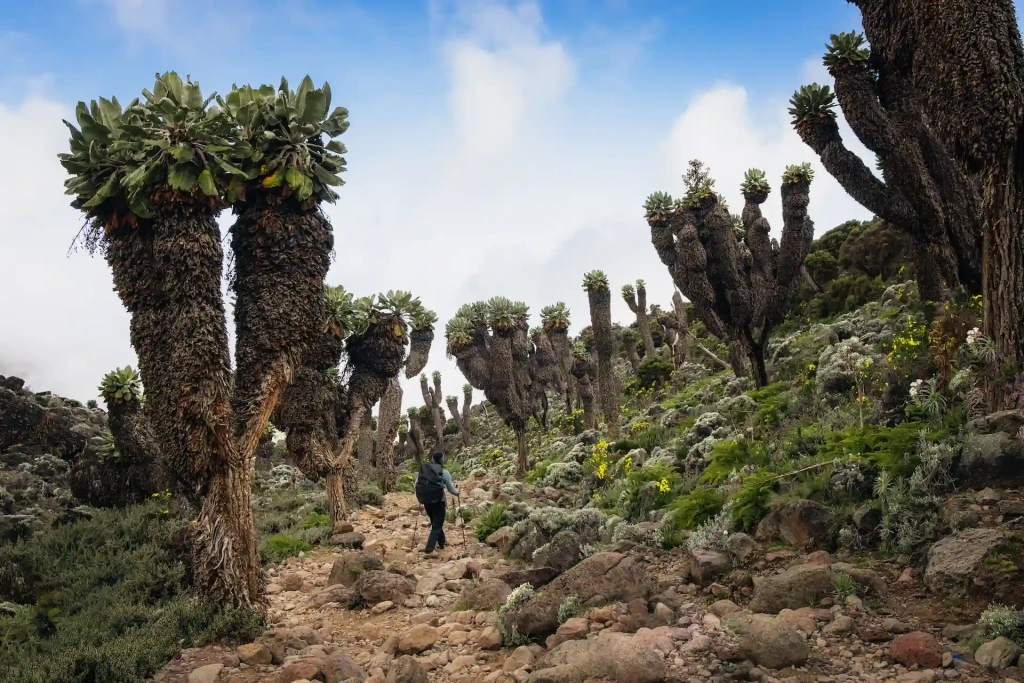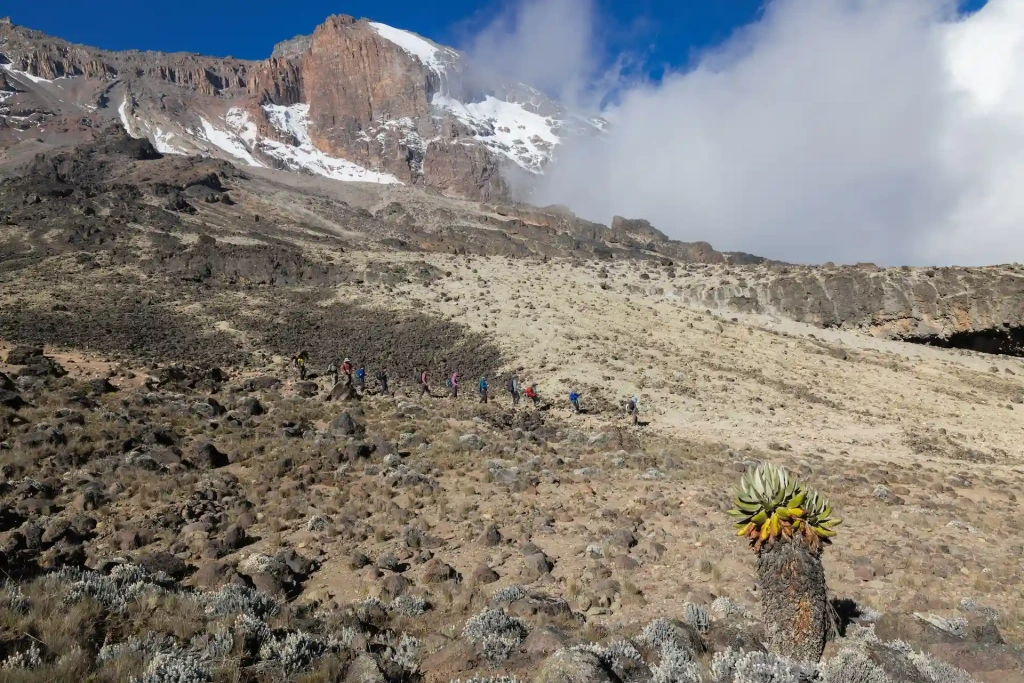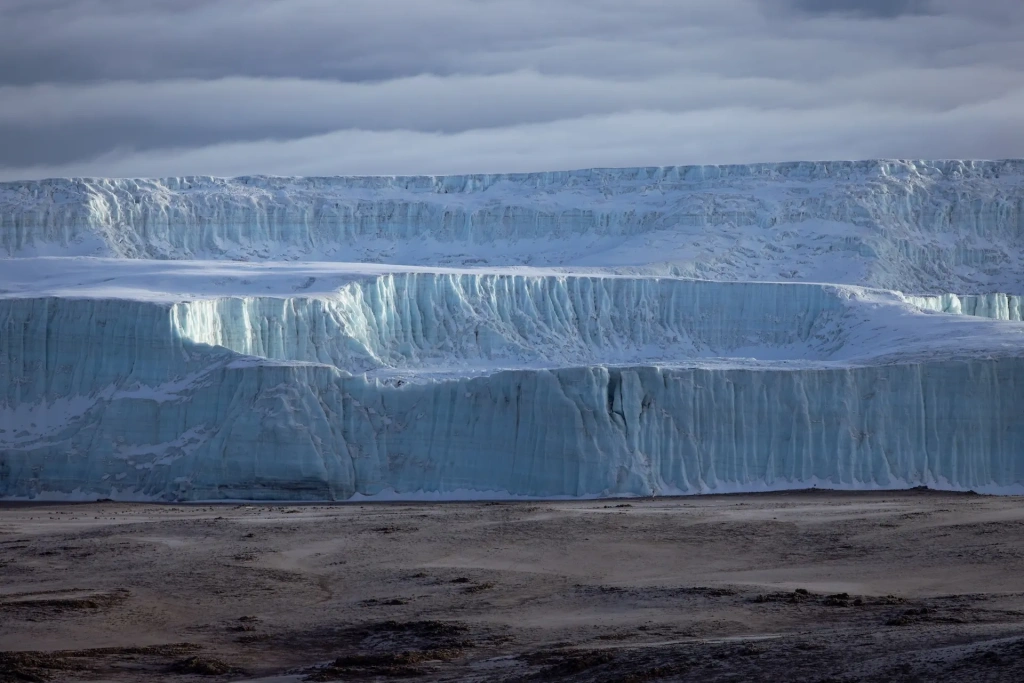At 5,895 meters (19,341 feet), Mount Kilimanjaro is Africa’s highest peak. It offers climbers a journey through a stunning variety of climates and landscapes. As you make your way up the mountain, the shifts in the environment are dramatic. From dense rainforests to barren alpine deserts and eventually, to the snow-covered summit, Kilimanjaro has it all.
In this article, we’ll take a closer look at Kilimanjaro’s five main climate zones, describing what makes each one unique. You’ll also find useful tips on the kind of weather to expect in each zone and how to dress for the conditions at every stage of the climb.
The five distinct climate zones of Kilimanjaro
The slopes of Mount Kilimanjaro are divided into distinct climatic zones, each with its unique landscape, vegetation, weather, and wildlife. Mountain enthusiasts who decide to climb Kilimanjaro experience dramatic changes in these zones, each offering something different. The trek to Uhuru Peak is likened to a journey from the tropics to the North Pole. Here’s why.
The slopes of Kilimanjaro feature five different climatic zones that change with altitude:
- Cultivated Zone
- Rainforest Zone
- Heather and Moorland Zone
- Afro-alpine Desert Zone
- Arctic Zone.
Let's explore Mount Kilimanjaro's different climate zones, noting the changes in conditions as we ascend. This will help you understand what climbers should be prepared for at each stage.
Cultivated Zone
Kilimanjaro's lowest elevation climate zone is the Cultivated Zone (or Cultivation Zone). Once covered in and characterized by sparse shrubs, this area is filled with populated human settlements. Residents cultivate crops in the fertile volcanic soil, transforming the landscape of this altitude belt. This is especially true on the southern and western slopes, while the northern and eastern sides are more arid.
Altitude: 800–1,800 meters (2,625–5,905 feet).
Landscape: The area is dotted with villages of the Chagga people, along with farms and extensive agricultural fields. The most commonly grown crops include maize, bananas, and coffee. Tanzanian coffee, in particular, flourishes in the nutrient-rich volcanic soil, producing a flavorful, premium-quality product.
Daytime temperature: +21 to +32°C (+70 to +89°F).
Nighttime temperature: +15 to +27°C (+59 to +81°F).
Animals you might see here: blue monkeys, bushbabies, genets, civets, ibises, hornbills, squirrels, mongooses, and occasionally tree hyraxes, along with other creatures that live near human settlements.
Birdwatchers can look out for the striking sunbirds with their iridescent plumage, long-tailed mousebirds, and melodious shrikes.
For those interested in local livestock, you’ll often see humped Zebu cattle, commonly raised by the villagers, wandering along the roads.
What to expect in the zone: Ascents start in the Rainforest Zone just beyond the cultivated areas. In this lower zone, you'll find hotels where travelers rest before and after their climb. During warm months, t-shirts and shorts are comfortable for the daytime. For evenings or during the rainy season, you'll need pants, shirts, and light jackets. This area also offers beautiful waterfalls for excursions, with Materuni Falls being the most popular and scenic.
Rainforest Zone
Beyond the settlements, the montane tropical Rainforest Zone begins. No farming or economic activity is permitted in this continuous dark green band, as this area is part of Kilimanjaro National Park. The park's gates mark the entrance to the Rainforest Zone, signaling the start of the protected wilderness.
This area is called the Rainforest Zone due to its annual rainfall of up to 2,000 mm (80 inches). Roughly 96% of Kilimanjaro's water originates from this forest. The forest is densest on the southern slopes, with vegetation becoming sparser to the east and west. On the northern slopes, you'll find more coniferous trees. The Rain Forest Zone is the most biologically diverse region of the mountain, home to a wide variety of plant and animal species.
Altitude: 1,800–2,800 meters (5,905–9,185 feet).
Landscape: The montane forest blankets the slopes of Mount Kilimanjaro, particularly on the southern side. Here, you'll find Africa’s tallest tree, Entandrophragma excelsum, which can grow up to 81.5 meters (267 feet). This diverse mix of tree species and plants creates a resilient ecosystem that attracts a wide range of birdlife. Rivers originating higher on the mountain gather strength in the Rainforest Zone, tumbling down steep, rocky slopes like impressive waterfalls. Bamboo groves are more common in the north and northwest areas.
Daytime temperature: +15 to +20°C (+59 to +68°F).
Nighttime temperature: +4 to +15°C (+39 to +59°F).
Animals you might see here: Black-and-white colobus monkeys, with their luxurious fur and long, fluffy tails, stand out as one of the most striking species in the forest. Whether you spot other wildlife depends on your attentiveness and a bit of luck. The forest is also home to honey badgers, bushpigs, and various forest antelopes, including the rare Abbott’s duiker, which is endemic to the region. In addition to colobus monkeys, you might encounter blue monkeys and olive baboons.
Some of the most elusive forest inhabitants of Mount Kilimanjaro are leopards, civets, genets, and mongooses. On the western slopes and slightly higher up, on the Shira Plateau, you might spot lions. Additionally, at these elevations, western and northern slopes often serve as grazing grounds for elephants, buffaloes, large cane antelopes, and even giraffes.
The forest has many birds, including the endemic Kilimanjaro White-eyes and the stunningly beautiful Hartlaub's Turaco.
What to expect in the zone: The forest will be the first stage of the ascent on Kilimanjaro and the final stage during the descent. To traverse this area, we recommend wearing a T-shirt and trekking pants. It is better to carry a fleece jacket along with wind—and water-resistant clothing. Lightweight trekking shoes are preferable.
Heather and Moorland Zone
At 2,800 meters (9,185 feet), the dark green areas transition to the climatic zone commonly known as the Heath and Moorland Zone. The most striking feature of this area is the giant heather bushes that dot the landscape. Here, you'll find open spaces where trees are absent. The ground is strewn with boulders and volcanic rocks covered in grasses, with marshy areas found on the Shira Plateau. The plants that thrive at this altitude have adapted to the harsh conditions. They store water in their stems and leaves, tolerate low temperatures, and withstand strong winds. Animal life is sparse here, especially the larger species rarely spotted.
Altitude: 2,800–4,000 meters (9,185–13,125 feet).
Landscape: This climate zone is also known as the Low Alpine Desert. It is a semi-alpine zone with relatively green areas filled with grasses, shrubs, and flowering plants. While the flowers may not be particularly vibrant, they add color to the otherwise brownish-green mountain meadows.
You'll eventually come across the incredible tall plants: giant lobelias and Kilimanjaro groundsels (Dendrosenecio kilimanjari). For those unfamiliar with the mountains of East Africa, these unique plants might seem otherworldly. Some can grow up to 10 meters (33 feet) tall. They appear incredibly mysterious in the fog, resembling massive candelabras.
On clear days, this zone provides stunning views of the surrounding landscapes, including Mount Pare, the neighboring Meru volcano, and occasionally Mount Kenya, depending on your vantage point.
Daytime temperature: +10 to +21°C (+50 to +70°F).
Nighttime temperature: -1 to +10°C (+30 to +50°F).
Animals you might see here: Among the larger animals, you may encounter elands, common duikers, klipspringers, buffaloes, and occasionally elephants and African wild dogs. As mentioned earlier, lions migrating through this zone are occasionally spotted on the Shira Plateau. Observant travelers may also spot four-striped grass mice and other rodents.
The most frequently spotted bird in this area is Moorland Chat. If you keep an eye on the sky, you might catch sight of large raptors like Augur Buzzard, Mountain Buzzard, Crowned Eagle, and Bearded Vulture. This zone is also home to numerous White-necked Ravens, notable for their large size and distinctive white patches on the back of their necks.
What to expect in the zone: This is an open area with little shade on sunny days, making sunglasses and a wide-brimmed hat essential. High humidity is a constant feature here. At elevations above 3,000 meters (9,845 feet), you'll frequently find yourself walking through clouds and encountering fog. This calls for water-resistant jackets and ponchos. Layering regular pants with membrane trousers is wise, as wind and rain are expected at this altitude. It’s also a good time to switch to sturdy trekking boots for better support and protection.
Afro-alpine Desert Zone
Above the Heather Moorland lies a rugged rocky desert, where the landscape is scattered with stones and almost devoid of vegetation. The only organisms that can survive here are mosses and lichens. The climate can be summed up as "summer every day and winter every night." In this zone, temperatures fluctuate dramatically—from 25°C (77°F) during the day to light frosts at night.
Altitude: 4,000–5,000 meters (13,125–16,405 feet).
Landscape: This zone is often referred to as the Alpine Desert Zone. However, given this region's unique flora and fauna, it is more accurately called the Afro-alpine Desert. While you can still find some grasses, there is little natural vegetation. Around Mawenzi, you'll notice sharp, upward-pointing rock formations, and a rocky saddle connects Mawenzi to the central dome of Kibo.
Daytime temperature:
Nighttime temperature: -12 to +4°C (+10 to +39°F).
Animals you might see here: Animals that wander into this zone usually pass through while migrating between slopes. Some sightings include elands, leopards, servals, and African wild dogs. However, there are no permanent residents here. Scientists studying Kilimanjaro’s high-altitude desert tend to focus on its insect life. While some birds, like ravens and large raptors, may migrate to this area, they do not stay permanently.
What to expect in the zone: Prepare for intense sun during the day and freezing cold at night. Since the clouds that filter sunlight are at lower elevations, protecting your skin from ultraviolet radiation is crucial. In the morning and evening, layer up with fleece jackets, insulated coats, warm pants, socks, buffs, and other warm clothing. At night, a good sleeping bag and heat sources will be essential. Avoiding chills and keeping your body and clothes dry is vital. At this altitude, it's easy to experience symptoms of Acute mountain sickness, so be ready for the challenges Kilimanjaro presents.
Arctic Zone
This is the final zone for climbers eager to reach Uhuru Peak. The weather conditions mirror the Arctic's above 5,000 meters (16,405 feet). During the day, climbers face intense solar radiation, and temperatures can drop drastically at night. Glaciers at the summit are hidden beneath snow that may last for days or weeks.
Altitude: 5,000–5,895 meters (16,405–19,341 feet).
Landscape: This is the cold summit of Kilimanjaro, where rocks are often blanketed in snow that lingers even during the day. The Kibo Dome features a crater, and once you reach it, there are just about 150 meters (492 feet) left to Uhuru Peak, the highest point on Kilimanjaro at 5,895 meters (19,341 feet) above sea level. The largest glacier fields are located on the northern and eastern sides of the crater, with additional glaciers scattered throughout other areas as well.
Daytime temperature: -12 to -4°C (+10 to +25°F).
Nighttime temperature: -30 to -7°C (-22 to +19°F).
Animals you might see here: None. The only visitors to this harsh environment are White-necked Ravens, and they don’t linger for long. Historical reports of large animals in this area are rare. The most notable case is the frozen carcass of a leopard, described by Richard Reusch and famously recounted by Ernest Hemingway in his book "The Snows of Kilimanjaro." Another report mentions five African wild dogs that made it to the summit. The first finding was in 1926, while the second incident occurred in 1962. Overall, encounters with living animals here are improbable. However, frozen carcasses of animals can still occasionally be discovered in the glaciers.
What to expect in the zone: Mountain medicine classifies this zone as "extreme altitude." Be ready for freezing temperatures, intense sunlight, and dry air that can quickly dehydrate you. Make sure to wear all the warm clothing you have.
Want to learn more about Kilimanjaro? Read other articles on Kilimanjaro and climbing tours in our blog.
If you're ready for a Kilimanjaro climb and want to embark on a week-long journey from tropical landscapes to Arctic ice without leaving Tanzania, join us for our group tours to Kilimanjaro. Our experienced and well-prepared guides from Altezza Travel will lead you through all the climate zones, allowing you to witness the Roof of Africa firsthand.
All content on Altezza Travel is created with expert insights and thorough research, in line with our Editorial Policy.
Want to know more about Tanzania adventures?
Get in touch with our team! We've explored all the top destinations across Tanzania. Our Kilimanjaro-based adventure consultants are ready to share tips and help you plan your unforgettable journey.















